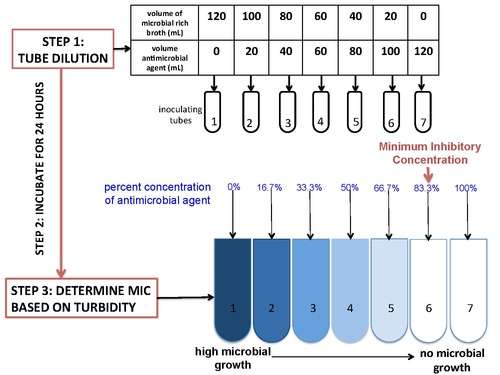Minimum inhibitory concentration
In microbiology, the minimum inhibitory concentration (MIC) is the lowest concentration of a chemical that prevents visible growth of a bacterium (in other words, at which it has bacteriostatic activity), whereas the minimum bactericidal concentration (MBC) is the concentration that results in microbial death (In other words, the concentration at which it is bactericidal).[1]
The MIC of a chemical is determined by preparing solutions of the chemical at increasing concentrations, incubating the solutions with the separate batches of cultured bacteria, and measuring the results using agar dilution or broth microdilution, usually following the guidelines of a reference body such as the CLSI, BSAC or EUCAST (European Committee on Antimicrobial Susceptibility Testing).[2]
In medicine, culturing the organism infecting a patient with available antibiotic drugs and determining the MICs, is important for identifying the correct drug to actually give to the patient.[2][3]
The first step in drug discovery programs is often the screening of a library drug candidates for MICs against bacteria of interest.[4] As such, MICs are usually the starting point for larger preclinical evaluations of novel antimicrobial agents.[5]

References
- ↑ Tripathi, K.D. (2013). Essentials of Medical Pharmacology (7th ed.). New Delhi, India: Jaypee Brothers Medical Publishers. pp. 696,697.
- 1 2 Andrews, J. M. (1 July 2001). "Determination of minimum inhibitory concentrations". Journal of Antimicrobial Chemotherapy. 48 (suppl 1): 5–16. doi:10.1093/jac/48.suppl_1.5. PMID 11420333.
- ↑ Yamamoto, Loren G. (February 2003). Chapter VI.4. Inhibitory and Bactericidal Principles (MIC & MBC). Case Based Pediatrics For Medical Students and Residents, University of Hawaii John A. Burns School of Medicine
- ↑ Turnidge JD, Ferraro MJ, Jorgensen JH (2003) Susceptibility Test Methods: General Considerations. In PR Murray, EJ Baron, JH Jorgensen, MA Pfaller, RH Yolken. Manual of Clinical Microbiology. 8th Ed. Washington. American Society of Clinical Microbiology. p 1103 ISBN 1-55581-255-4
- ↑ O'Neill, AJ; Chopra, I (August 2004). "Preclinical evaluation of novel antibacterial agents by microbiological and molecular techniques.". Expert Opinion on Investigational Drugs. 13 (8): 1045–63. doi:10.1517/13543784.13.8.1045. PMID 15268641.